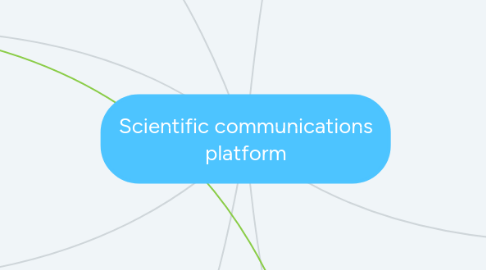
1. Collection:Evidence monitoring
1.1. Source
1.1.1. Congress
1.1.1.1. Pilot phase: ADA/EASD
1.1.1.2. Extended phase: key congress in focused TA: cardiovascular, oncology, hematology, immunology
1.1.2. Database
1.1.2.1. Pubmed (pilot phase)
1.1.2.2. Wangfang (extend phase
1.2. Requirement/feature
1.2.1. Consistent with source
1.2.2. De-dupilication rules
1.2.3. specific search strategy custmization
1.2.3.1. all in one search function of multiple sources
1.2.3.2. could add tag/description to search strategy
1.2.3.3. Multiple search strategy management
1.2.3.3.1. Set RSS feed
1.2.3.3.2. Set e-mail alert on a routine basis
1.2.3.4. system could recommend search strategy based on user input
1.2.4. Share search strategy with group
1.2.4.1. user could follow other's search strategy
2. Label-Evidence key information extraction & tagging
2.1. Dimension
2.1.1. General information
2.1.1.1. Author
2.1.1.1.1. Affiliation
2.1.1.2. Year
2.1.1.3. Journal
2.1.1.3.1. Impact factor
2.1.1.3.2. Summary
2.1.1.3.3. Affiliated society
2.1.1.4. Congress
2.1.1.5. Language
2.1.1.5.1. English
2.1.1.5.2. Chinese
2.1.1.5.3. ...
2.1.2. Article type
2.1.2.1. Editorial/Commentary
2.1.2.2. Original article
2.1.2.3. Review
2.1.2.4. Letter to editor
2.1.2.5. Case report
2.1.2.6. ...
2.1.3. Key word
2.1.4. Disease
2.1.5. Study
2.1.5.1. Study type
2.1.5.1.1. secondary data
2.1.5.1.2. Primary data
2.1.5.2. Specific information
2.1.5.2.1. Population
2.1.5.2.2. Endpoint
2.1.5.2.3. Product/drug tested
2.1.5.2.4. Patient source
2.1.6. Full article
2.1.6.1. Available
2.1.6.2. Not available
2.1.7. custom Tag
2.1.7.1. User-added tag
2.1.7.1.1. Public
2.1.7.1.2. Private
2.1.8. Citation
2.1.8.1. cited by
2.1.8.2. Reference
2.1.9. funding sponsor
2.2. Requirement feature
2.2.1. Quality check
2.2.2. Correction
2.2.3. Machine performance optimization
2.2.4. Print
2.2.5. Add to list/collection
2.2.6. Share with colleague/peer/group
2.2.7. e-mail
2.2.8. Download/multiple download
3. Analysis: evidence analysis (qualitative & quantitative) tier 2 filtering - digestion
3.1. Quantitative
3.1.1. Publication trend
3.1.1.1. By year
3.1.2. Quantity comparison
3.1.2.1. By product
3.1.2.2. Between product
3.1.3. Feature
3.1.3.1. Based on key information tags
3.2. Qualitative
3.2.1. Key word clustering
3.3. Feature
3.3.1. Display
3.3.1.1. filter
3.3.1.1.1. Access type
3.3.1.1.2. year
3.3.1.1.3. Author name
3.3.1.1.4. disease area
3.3.1.1.5. document type
3.3.1.1.6. Study type
3.3.1.1.7. publication status
3.3.1.1.8. source title
3.3.1.1.9. key word
3.3.1.1.10. Affliation
3.3.1.1.11. funding sponsor
3.3.1.1.12. Country/territory
3.3.1.1.13. Source type
3.3.1.1.14. Language
3.3.1.2. search within results
3.3.1.3. Add to list/collection
3.3.1.4. Export
3.3.1.5. Download
3.3.1.6. Print
3.3.1.7. Mail
3.3.1.8. Share via
3.3.1.9. Purchase full article
3.3.1.10. customized view
3.3.1.10.1. Sort by
4. Processing
4.1. Article selection and category management
4.1.1. Group sharing
4.1.2. Voting
4.2. Export
4.2.1. With given document type
4.2.1.1. With given key information
4.3. Full article multiple download
4.4. Auto translation
4.5. Interact
4.5.1. view peer's recommendation
4.5.2. View KOL's recommendation
4.5.3. Raise idea/discussion
4.5.4. Apply for study support
5. Visualization & report
5.1. Feature
5.1.1. Dashboard
5.1.1.1. Since last visit
5.1.1.2. All time
5.1.1.3. Quick glance report
5.1.2. Infographic
5.1.2.1. Based on selected tag/key information
5.1.3. Intelligence report
5.1.3.1. Treatment landscape
5.1.3.2. Disease area hot topic
5.1.3.3. On a given topic
5.1.3.4. HCP mapping
5.1.4. Filter
5.1.5. Prioritization
5.1.5.1. Base on date/IF/relevance
5.2. Knowledge ATLAS
6. Supported medical writing
6.1. Sequential workflow management
6.1.1. Author engagement
6.1.1.1. Invitation
6.1.1.2. Review/feedback
6.1.1.3. COI automation
6.1.1.4. Disclosure automation
6.1.2. Planning
6.1.2.1. Publication planning
6.1.2.2. Target journal/congress identification
6.1.2.2.1. Journal/congress recommendation
6.1.2.3. Timeline/gan-chartt
6.1.3. Delivery
6.1.3.1. Structure medical writing module
6.1.3.1.1. CONSORT for RCT
6.1.3.1.2. STROBE for oberservational
6.1.3.1.3. PRISMA for SR & META
7. User
7.1. General information
7.1.1. Name
7.1.1.1. Orcid
7.1.2. Affiliation
7.1.2.1. Department
7.1.3. Personal summary
7.1.3.1. H-index
7.1.3.2. Authorship
7.1.3.2.1. As 1st author
7.1.3.2.2. As corresponding author
7.1.3.2.3. As other co-author
7.1.3.2.4. H-index
7.1.3.2.5. Network
7.1.4. Tag
7.1.4.1. Focused area
7.1.4.2. Research direction
7.2. HCP user Journey
7.2.1. Define search strategy across multiple information source
7.2.2. Receive RSS feed or mail alert, view digested report/summary
7.2.3. Share search strategy with peer
7.2.4. Follow peer's search strategy
7.2.5. Share personal's academic achievement with peer
7.2.6. View peer's academic achievement
7.2.7. Create personal OrcID to avoid future publication information confusion
7.2.8. Take advantage of advanced analytics to identify research gap
7.2.9. Use group function to manage journal club
7.2.10. Take advantage of advanced analytics to support study/research planning
7.2.11. Take advantage of supported medical writing module to develop manuscript
7.2.12. Take advantage of journal/congress selector to identify potential target journal/congress
7.2.12.1. Raise pre-submission enquiry to publisher/target journal
7.2.13. Take advantage of workflow management module to facilitate co-author communication
7.2.14. Raise a study idea and gain support/collaboration from peer/industry
7.2.15. Add selected article to list/collection
7.2.16. Generate/update personal COI
7.2.17. Record authorship contribution in a more transparent way
7.3. Industry user journey
7.3.1. define search strategy across multiple information source
7.3.2. receive RSS feed or mail alert
7.3.3. share search strategy with colleague
7.3.4. follow colleague's search strategy
7.3.5. Learn study/research interest clustering of a given therapeutic area
7.3.6. Learn study/research trend clustering of a given therapeutic area
7.3.7. Take advantage of advanced analytics to support strategic planning
7.3.8. Take advantage of advantage analytics to perform KOL mapping
7.3.9. Support specific journal club initiative
7.3.9.1. Engage TOP KOL to form editorial board
7.3.10. Support specific study idea
7.3.10.1. ISS
7.3.10.2. CSS
7.3.11. Take advantage of support medical writing module to prepare scientific communications material
7.3.11.1. Promotion/non-promotion material
7.3.11.2. Publication
7.3.11.2.1. Target journal/congress identification
7.3.11.2.2. Publication planning
7.3.11.2.3. Author engagement and communication
7.3.12. Add selected article to list/collection
7.3.13. Report HCP payment in a more transparent way
7.4. Publisher user journey
7.4.1. Handle pre-submission enquiry
7.4.2. Authorize journal club initiative funded by industry
7.4.3. Enlarge journal's outreach and impact to extended audience
7.4.4. Sell full-article access
7.4.5. view full authorship contribution details
7.5. Credit system
7.5.1. certain action would be awarded credit
7.5.2. Credit could be used to order service, eg. get full article

